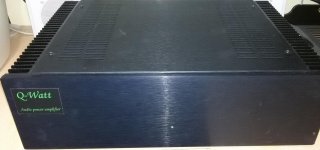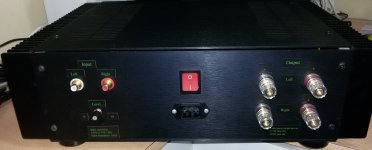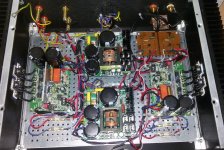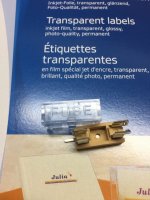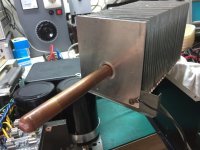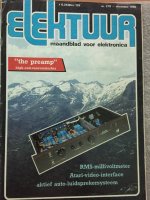I'm really pleased with the sound quality at low levels ~1 Watt. It's really important for domestic use day to day.
I found a good looking DIY DAC: search for DA24QS. Maybe next project...
At least biwiring has reduced my cable resistance by a factor of 4. Resistance was very low though even with original 5m length. Too low for me to measure.
Pops
I found a good looking DIY DAC: search for DA24QS. Maybe next project...
At least biwiring has reduced my cable resistance by a factor of 4. Resistance was very low though even with original 5m length. Too low for me to measure.
Pops
Since the Q-Watt damping factor is so high, and output impedance so low, there is a theoretical improvement in overall damping factor by reducing cable impedance to <15 mR. Audible? I doubt it...
You need to put things in perspective: cable resistance is usually expressed by 1000 meters. In your home, the typical cable length is way less than 1000 meters (example 5 meters).
Example: the Sommer cable 425-0051 has a resistance of 7.5 ohms per 1000 meters. So you 5 meter speakers cable would have a cable resistance of 0.0375 ohms. Even cutting that value by 4 is meaningless.
Example: the Sommer cable 425-0051 has a resistance of 7.5 ohms per 1000 meters. So you 5 meter speakers cable would have a cable resistance of 0.0375 ohms. Even cutting that value by 4 is meaningless.
Well, the contact resistance at the terminals is way higher than that anyway. And while we are at that, gold plated terminals are crap. Why? Because before the gold plating they are nickel plated and since every layer of different material adds another contact resistance, it's worse than nickel only.
Don't forget the skin effect.
My house came with some built in speaker cables, but they are on the slim side.
I'm also currently running multi-room, i.e. another pair of speakers in the kitchen, which is a lot more than 5m of wire.
The skin effect is not a concern for frequencies in the audio domain. It becomes a factor in high frequency systems; way above the audio spectrum.
Dear,
I was just searching the internet for others who made the q watt amplifier. I made one last year.
I am also working on a website which is not ready yet. I want to post also my parts list, etc.
For who are interested here is my q-watt project.
Development of a DIY High-end Amplifier
Best regards,
Frank
I was just searching the internet for others who made the q watt amplifier. I made one last year.
I am also working on a website which is not ready yet. I want to post also my parts list, etc.
For who are interested here is my q-watt project.
Development of a DIY High-end Amplifier
Best regards,
Frank
I was interested in building a pair of these amps. But history repeats, as always with Elektor projects:
Around 1976 the Equa amp,
1980 Power PA
1985 Crescendo
some essential parts are unobtanium. Why do they always pick parts that are not available or phased out a year or two after they presented it? Exactly because of this problem with potential spare parts, I will not buy one of the last kits available.
Also, sometimes it took a very long time until all little faults of these projects were officially sorted out. "We had some problems with parts from different manufacturers" was the standardized answer.
Funny enough in about 40 years of successfully building audio stuff, it was always and only Elektor kits making problems. As an old technician told me once: Their amps always oscillate, their oscillators never. They leave the beta testing it to their customers. They love it to sort out design mistakes by them selves.
So now, because I don't get the transistors for the Q-watt, probably I will never experience a working Elektor amp. I'm really sad.
Around 1976 the Equa amp,
1980 Power PA
1985 Crescendo
some essential parts are unobtanium. Why do they always pick parts that are not available or phased out a year or two after they presented it? Exactly because of this problem with potential spare parts, I will not buy one of the last kits available.
Also, sometimes it took a very long time until all little faults of these projects were officially sorted out. "We had some problems with parts from different manufacturers" was the standardized answer.
Funny enough in about 40 years of successfully building audio stuff, it was always and only Elektor kits making problems. As an old technician told me once: Their amps always oscillate, their oscillators never. They leave the beta testing it to their customers. They love it to sort out design mistakes by them selves.
So now, because I don't get the transistors for the Q-watt, probably I will never experience a working Elektor amp. I'm really sad.
So now, because I don't get the transistors for the Q-watt, probably I will never experience a working Elektor amp. I'm really sad.
A friend and colleague build the Elektor Crescendo years ago, and had nothing but praise for it. That's why I went for the Q-Watt. The cost is in the case and power supply anyway. Just stop grumbling and fork out for 2x Elektor kits. If it goes wrong in ten years then build something else using the same case and power supply.
Mine runs continuously. Uses about 23W at idle (2 channels) and gets REALLY loud before you get to 24W. Never gets warm. Will probably last forever.
Pops
Check out
Q-Watt - Simple Audio Power Amplifier (110656) - Elektor LABS
You'll see '2SA2223A/2SC6145A from Sanken. Available at Digi-Key.'
Q-Watt - Simple Audio Power Amplifier (110656) - Elektor LABS
You'll see '2SA2223A/2SC6145A from Sanken. Available at Digi-Key.'
I'm a bit late but it looks like an very old Philips potmeter.I have completed my first prototype passive preamp
But history repeats, as always with Elektor projects:
Around 1976 the Equa amp,
1980 Power PA
1985 Crescendo
some essential parts are unobtanium.
EQUA was in 1970, Crescendo in 1982, btw. The PowerPA is unknown to me.
All components of the EQUA amp still are available. Maybe you want to replace the power devices for more recent ones, like MJ15003/04 or MJ21193/94, which work very well. I've built about a dozen of EQUA's in the 1970ies, but I'll never build any again, mainly due to their overload protection that simply doesn't work. Besides this it is a rather good sounding amplifier.
Best regards!
Q-Watt
Although my Elektor Q-Watt has been up and running for some time, pumping out great quality sound, here are some images of my beast for the late builders.
Although my Elektor Q-Watt has been up and running for some time, pumping out great quality sound, here are some images of my beast for the late builders.
Attachments
They leave the beta testing it to their customers. They love it to sort out design mistakes by them selves.
Okay, so I'm a beta tester then.
As a beta tester I can say that the Q-Watt is an excellent amp and works great.
So now, because I don't get the transistors for the Q-watt, probably I will never experience a working Elektor amp. I'm really sad.
Simply buy two kits from Elektor. They are still available and include all transistors: Q-Watt – Audio Power Amplifier (110656-71) - Elektor
Professional Amp
A few comments with constructive criticism, the labels at the backside are not really nice, if I can give a suggestion, why do you don't use transparant labels, it is easy to make with for example Photoshop print it and you can stick on the back without problems.
The transistors with wires on the heatsinks is contrary to what others said in my opinion a good idea because the expansion of the leads while warming up is now no problem anymore. If they are direct mounted on the print it is possible that cracks arise at the soldering joints sooner or later.
The fuseholders don't have covers?
I'm still very satisfied with my Q-Watt in the old Marantz 250 case and I intend to build a second again in the case of an old Marantz SM-6.
This amp has as cooling a heatpipe, I think it will not be easy to fix it but I'll give it a try.
Anyway I wish you much 'Listen' pleasure.
Looks great Calp.Although my Elektor Q-Watt has been up and running for some time, pumping out great quality sound, here are some images of my beast for the late builders.
A few comments with constructive criticism, the labels at the backside are not really nice, if I can give a suggestion, why do you don't use transparant labels, it is easy to make with for example Photoshop print it and you can stick on the back without problems.
The transistors with wires on the heatsinks is contrary to what others said in my opinion a good idea because the expansion of the leads while warming up is now no problem anymore. If they are direct mounted on the print it is possible that cracks arise at the soldering joints sooner or later.
The fuseholders don't have covers?
I'm still very satisfied with my Q-Watt in the old Marantz 250 case and I intend to build a second again in the case of an old Marantz SM-6.
This amp has as cooling a heatpipe, I think it will not be easy to fix it but I'll give it a try.
Anyway I wish you much 'Listen' pleasure.
Attachments
May I remind you at December 1986, in "Elektuur" the best pre-amp ever: "the preamp" including adjustable MC and MM sensitivityI was interested in building a pair of these amps. But history repeats, as always with Elektor projects:
Around 1976 the Equa amp,
1980 Power PA
1985 Crescendo
some essential parts are unobtanium. Why do they always pick parts that are not available or phased out a year or two after they presented it? Exactly because of this problem with potential spare parts, I will not buy one of the last kits available.
Also, sometimes it took a very long time until all little faults of these projects were officially sorted out. "We had some problems with parts from different manufacturers" was the standardized answer.
Funny enough in about 40 years of successfully building audio stuff, it was always and only Elektor kits making problems. As an old technician told me once: Their amps always oscillate, their oscillators never. They leave the beta testing it to their customers. They love it to sort out design mistakes by them selves.
So now, because I don't get the transistors for the Q-watt, probably I will never experience a working Elektor amp. I'm really sad.
Still in use, now together with the Q-Watt, of-course I can't compare with Mark L. but in my opinion a Masterful Duo.
This is in contrast to the problems you have with Elektor.
Attachments
- Home
- Amplifiers
- Chip Amps
- My Q-Watt project
